Construction vacuum cleaner: the principle of operation and the subtleties of choice

You will not surprise anyone with the presence of a household vacuum cleaner today - it is in every home, and without it in our time it is already difficult to imagine the usual cleanliness of dwellings. Another thing is that the household model is designed to solve only relatively simple tasks - it will remove everyday dust, but it can go awry even where it has simply not been cleaned for a very long time.
At the same time, some types of human activity involve the formation of huge volumes of garbage every day, in connection with which the need for some more powerful equipment becomes obvious. In such a situation, nothing will help out better than a construction vacuum cleaner.

Peculiarities
The desire to live in purity, inherent in most modern people, is not some purely aesthetic whim, but a subconscious desire to protect oneself from various dangers. Everyone knows that fine dust, as well as pollen, provoke allergies in some people, but some jobs require even more difficult conditions.
Various construction sites, as well as workshops engaged in sawing various materials, are constantly contaminated not only with large construction debris, but also with fine dust, and that, getting into the lungs and eyes, can cause considerable harm to health, not to mention the fact that for the very hardware, it is also not very useful.


The difference between a construction vacuum cleaner and a household one lies in the scale of the tasks being solved: the first is intended for construction or any other similar difficult conditions, while the household model is a lighter and cheaper version of its more serious brother. In general, these two types of technology are close to each other both in appearance and in the principle of operation, however, due to potentially different operating conditions, design differences may occur.


An industrial vacuum cleaner is being developed specially for collecting dust and heavy debris, it is designed for much more impressive volumes of collected substances. Let's imagine for a second that you would try to clean the construction site with an ordinary household vacuum cleaner: most likely, even small pebbles will not get into the dust collector, but the finest dust will freely seep through the filters and will be thrown back into the space of the room, and then pose a danger to your health.


In addition, a simple home unit, of course, provides for protection of the engine from dust, but in principle it is not designed for too much dust, so do not be surprised if the protection still does not work. Even if your home appliance is of good quality and high productivity, its dust collector is simply not designed for such amounts of waste, so a significant part of the time will be spent not so much collecting waste as cleaning the tank or bag.


Industrial models suggest design solutions designed to solve the problems described above. Among them, we highlight the most important points:
- shockproof housing it is designed to get inside even large fragments of debris at high speed, the unit itself will not suffer much, even if it capsizes on the unevenness of garbage heaps;
- increased hose diameter coupled with increased suction power, they contribute to the collection of not only dust, but also small and sometimes medium-sized pebbles, which would be difficult to collect by hand;
- enlarged dust collector allows you to make as few breaks as possible for servicing the vacuum cleaner, allowing you to collect a significant amount of waste at a time, which, of course, greatly increases the weight of the device;
- multistage filtration systems, as a rule, should be no worse than that of the best examples of household models in order to effectively filter out fine dust invisible to the naked eye and ensure ideal cleanliness of the room;
- engine construction vacuum cleaner is designed with the expectation of long-term operation, since in most cases the tasks solved by it cannot be solved in the shortest possible time (this is in sharp contrast to household vacuum cleaners, where the motors tend to heat up quickly, which is why they have to be turned off after a short time to avoid system overheating).


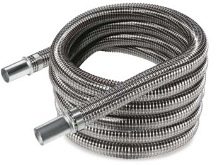
For these reasons, any place where punchers, wall chasers, jigsaws and any other type of sawing tools are used intensively should ideally be cleaned with a construction vacuum cleaner. Many models of the same saws are equipped with a special nozzle for a vacuum cleaner so that the dust formed during operation does not even theoretically get into the room - then it does not need to be removed, it is enough to literally turn on the unit, which is previously connected to the saw, for just a minute, and it will suck all the waste into the dust collector.
Moreover, some people prefer to use industrial vacuum cleaners even at home. In fairness, they rarely acquire a truly powerful unit - the choice usually falls on rather cheap and relatively weak models, which are sometimes comparable in performance to the most powerful examples of household vacuum cleaners.
This approach is justified if the home conditions are relatively difficult - for example, there are many carpets with long pile in the house, pets with regularly falling hair live right there, and some of the household members also have a strong allergy to dust.

Principle of operation
If we consider the principle of operation of an industrial vacuum cleaner in general terms, then it does not radically differ from the analogous principles of operation of its household counterpart. Inside the case there is a fan connected to an electric motor that drives it. Rotating, the fan blades create a zone of reduced pressure inside the housing, due to which, according to the laws of physics, the substance begins to be pulled up from the inside through a hose specially left for this purpose.
The dust collector takes over most of the waste, which is at least relatively heavy and unable to resist the gravitational force of the earth, while all fine dust that does not settle must be sifted out by additional filters. Previously sucked in air, already through another hole, is thrown back into the room.
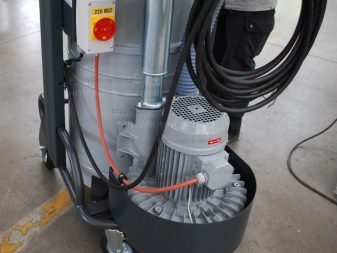

Unlike household vacuum cleaners, which collect garbage only when space is polluted, industrial vacuum cleaners can prevent this in the early stages. In this regard, there are three methods of cleaning.
- Suction from the working area involves fixing the suction end of the hose as close as possible to the workpiece being processed. The task of the employee is to find the optimal distance between them so that the cleaning efficiency is quite high, but at the same time does not create too much problems in the main work. This will not ensure a 100% cleanliness in the workplace, but all the same, this approach will greatly reduce the cleaning time due to the contamination of the workshop.


- Connecting a vacuum cleaner directly to the tool is most effective in terms of dust removal, although it can bring certain inconveniences to the workflow. Many modern tools, during the operation of which a large amount of sawdust or dust can form, are specially designed with a nozzle for connecting a vacuum cleaner. The design of the device is designed so that this branch pipe is located as close as possible to the place of waste generation, because due to this, they do not scatter around the room, but are instantly sucked up by a vacuum cleaner.
If the tool is hand-held and involves its active movement or turning during operation, the attached hose can greatly interfere with freedom of action, but then there is a choice between it and your own health.


As with any home vacuum cleaner, the industrial version allows cleaning after the fact of contamination. In this it is no different from standard household models.
What are they?
An industrial vacuum cleaner, like a household one, involves classification according to numerous criteria and characteristics. Before making a purchase, you should definitely compare all the available options, but for this you need to know what to look for.
First of all, even technical units for garbage collection are both bag and bagless. Each of these types is divided into two more subtypes: bag vacuum cleaners are equipped with either reusable fabric bags or disposable paper bags, and bagless vacuum cleaners come with a water or cyclone filter. Each of these types of equipment has its own advantages and disadvantages that deserve a separate study.


The dust bag, made of fabric, is good for reusability - after each cleaning, you just need to shake it out thoroughly and return it back to the bowels of the unit. Made of synthetic materials, a modern cloth bag for a vacuum cleaner costs a penny, but at the same time it is durable, therefore it is well known to the household user, who has probably seen it in a household appliance.
A clear disadvantage of this option is that even modern fabric bags usually do not shine with the amount of trapped fine dust that simply flies through them.


Paper bags are even cheaper than fabric ones, and they are appreciated for their ease of maintenance - it simply does not exist, the dust collector is also a garbage bag, so it does not need to be cleaned. The used paper bag is thrown away along with all its contents, it does not need to be washed and cleaned, which is a very significant advantage when working with debris and extremely fine dust.
Paper is much better than fabric at trapping fine dust, providing increased air purity, but at the same time it is not so strong, so that metal shavings, broken glass, or even just pebbles with pointed ends can easily pierce the bag.
If we talk about frank shortcomings, then here we include the need for regular replacement of the bag, which will cost a pretty penny over time, as well as the fact that this consumable often ends up at the most inopportune moment.


The container (cyclone vacuum cleaner) does not have any bag at all - inside its dust collector, a pneumatic vortex is formed, which, under the action of centrifugal force, throws all the collected particles to the walls, where they settle. Striking the inner walls of the dust container, all these particles create an increased noise, which is not always convenient.
In addition, the lightest dry particles do not want to obey even centrifugal force, therefore, objectively, such an aggregate is useful for cleaning only heavy or wet particles, as well as liquids. A certain plus is the partial compatibility of some cyclone vacuum cleaners with bags - thanks to this, you yourself decide which type your device belongs to right now. In doing so, be prepared that it can be quite difficult to clean the reservoir from the adhering dirt.


Aquafilter (water filter) assumes that the sucked-in air stream passes through a layer of water or particularly humid air, due to which most of even relatively light particles gain weight and settle in a water tank. The air purification does not end there, because a set of other filters is provided for the "surviving" debris, thanks to which the vacuum cleaner with an aquafilter shows consistently the best results among any analogues.
Despite the highest efficiency, the unit with an aquafilter is not so popular due to a number of disadvantagesfor example, it is not only the most productive, but also the most expensive. In addition, for such a mechanism to work, the reservoir must be filled with water, which should be the more, the more debris is expected to be removed. This means that such a design is both large and heavy, and clumsy, or not effective enough to correct all of these disadvantages.
Finally, for the normal operation of the vacuum cleaner, no consumables are required, except for water, but it may not be there in the conditions of the construction site.


Some experts insist that the construction and industrial vacuum cleaners that we are considering in this article are also divided into professional and household ones, and the latter should not be confused with those that we have repeatedly called home above.
- Professional An industrial vacuum cleaner is the most powerful and reliable machine that can work daily and in large quantities without any serious threat to the engine.
- Domestic a construction vacuum cleaner is much smaller and more modest, it is perfect for connecting a tool in a home workshop, for example, a grinder or a woodworking machine.
The simplified version is designed for slightly smaller volumes of debris and less frequent cleaning, since the engine safety margin is much more modest there, but if you do processing as a hobby and clean in the workshop once a week, then this should be enough.

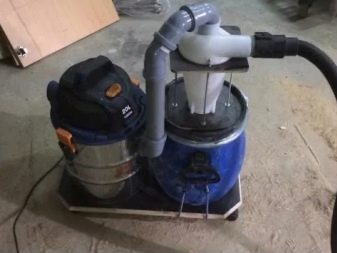
As in the situation with purely domestic models, construction vacuum cleaners can also be classified according to the type of pollution they are designed to combat. There are five most common categories of such equipment.
- The dry processing unit is extremely simple, it is similar to the cheapest models of its domestic counterparts. This option is better than the latter only in terms of the main numerical indicators: power, productivity, dust filtration efficiency. This is the best option specifically for a construction site, because it collects any dust well, and is relatively inexpensive.


- Devices for dry and wet cleaning have slightly extended protection against moisture ingress, therefore, with their help, even liquid can be collected from the floor. It is a one-stop solution that solves most problems.


- The washing vacuum cleaner can also collect dry garbage, but its main purpose is different - it is designed primarily for wet cleaning. An urgent need for such arises usually in various public places or various industrial premises. Not all people, by the way, understand that this is a vacuum cleaner, but according to the principle of operation, such a unit quite belongs to this category of technology.
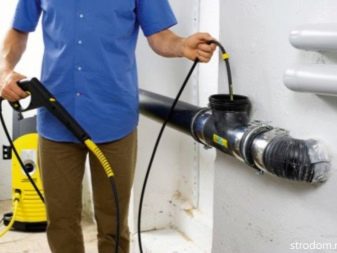

- To collect waste that presents an increased risk of ignition and even explosion, highly specialized vacuum cleaners are used. For some types of contaminants, such as coal dust, zinc or aluminum powder, even the slightest spark can cause a fire, and most typical vacuum cleaner motors are equipped with graphite brushes, which can spark during operation. In many cases, to increase fire safety, it is also necessary to accurately measure the speed of the intake air with its further regulation, which is provided for by the corresponding models.
Such high-tech equipment is very expensive, but where it is really needed, such costs are justified.


- Heat resistant vacuum cleaners - another category of specialized devices, the main feature of which is the ability of the body and all other parts to normally withstand interaction with highly heated particles. You will find such a technique even less often than the one described in the previous paragraph, but in the conditions of a metallurgical enterprise, where there may be a need for urgent collection of red-hot metal chips, such an assembly is indispensable.



Finally, it should be noted that most construction vacuum cleaners, due to their high performance, consume a huge amount of electricity, and therefore require constant contact with the outlet. At the same time, such a device was specially created for difficult conditions in all understandings of the word, and in fact it is often naive to rely on connected electricity in a building that is still under active construction.
At the same time, it is also necessary to clean such an area, therefore you can even find a rechargeable construction vacuum cleaner in the assortment of equipment stores. Due to the significant weight of the battery, such a unit usually has a very impressive mass, while still differing for the worse in terms of performance, but sometimes there is simply no alternative to it.

Rating of the best models
Ratings of any technique or equipment are always conditional due to the fact that the authors are almost certainly subjective. Devices are produced with different characteristics for that, that someone needs maximum productivity indicators, but for someone they turn out to be even superfluous, given the potential cost of a powerful unit. The same applies to convenience and a set of functions - someone is accustomed to relative asceticism and considers it normal, while for another person the very specificity of the tasks performed requires special skills from the purchase. The situation is further aggravated by the fact that on the modern market you can find many models of equipment that are very similar to each other, and even manufacturers regularly update the model lines, therefore even the most objective ratings are quickly losing relevance.
Considering all of the above, we fundamentally abandon the rating in the classical sense (with the distribution of seats), and instead we will make a small overview of current models that are in demand and collect good consumer comments.
In any case, the choice is yours - we do not even claim that our list contains the unit that would be ideal for you. When choosing candidates for review, we focused on the mass consumer, and if you have special needs, you may not find a suitable model among those presented by us.

Shop-Vac Micro 4
In general, it is very similar to simple home vacuum cleaners, and is usually used specifically for cleaning the house or occasionally cleaning in home workshops. Among its advantages, first of all, there are compactness, which is atypical for industrial units, as well as good suction power and the ability to work effectively in tight spaces - for example, in a car salon.
This model is usually praised for durability and high build quality, but not everything is so rosy - some users still complain that the hose can break on bends, and the procedure for replacing the nozzle is not very convenient.


Bort BSS-1010
In terms of compactness, it will give odds even to the above-described model, and modest characteristics, according to customer reviews, are quite sufficient for productive cleaning in the workplace. Of the positive aspects of this unit, one cannot fail to highlight the affordable prices for it and the assembly at the highest level.
The criticism mainly concerns only one, but very unusual point: the material of the case is not chosen very well, it is easily electrified and therefore attracts dust, so that the vacuum cleaner can easily become the most dusty object in your apartment.


"Soyuz PSS-7320"
A model of domestic production, and it was included in our list not because of some patriotism, but for certain characteristics. First of all, this is really a unit designed to work with a tool, because it has a power outlet on its body for parallel switching on and off of the tool and the vacuum cleaner at the touch of a button. The dust collector is designed for 20 liters of garbage, the vacuum cleaner itself can also perform wet cleaning - in a word, quite a worthy solution for those who have a house, a garage, and a workshop.
Moreover, such a device is also relatively inexpensive - domestic origin and the absence of the need for delivery from afar affects. In fairness, the developers saved not only on delivery - consumers also criticize the plastic case, which is not distinguished by outstanding reliability.
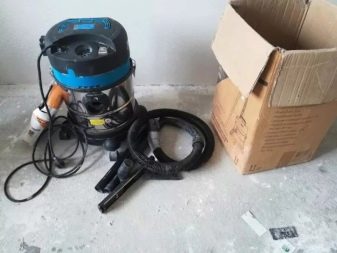

Makita VC2512L
This is a vacuum cleaner, worthy of consideration, if only because of the brand to which it belongs, because this Japanese company is known all over the world precisely because the creators are rarely ashamed of its products. True, this is not a top model, but it got into our list as meeting a number of criteria for a typical consumer. Such a unit is lightweight and relatively small, while providing good suction power and has a built-in socket for third-party tools and power up to 2.6 kW.
What they complain about here is a pipe made of metal - it is charged with static electricity and can sometimes be shocked, albeit slightly.


Bosch GAS 20 L SFC
The representative of another world famous brand of technology, now representing German quality. What any German product is famous for is the highest reliability and the same durability, and this construction vacuum cleaner will by no means become an exception to the general rule. From the above, you can guess another plus - shockproof housingwhich can be important in tough workshop conditions.
Such a device is appreciated both for its decent suction power and for the convenience of washing the filters. As is often the case with really good technology, there is only one drawback, but a significant one, and that is the price.
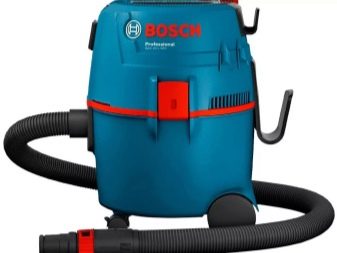

Karcher WD 3 Premium
Represents a company that is primarily known as a manufacturer of high quality harvesting equipment. This model is most often acquired as compact solution, which is notable for its modest dimensions and the same weight. What is also important is the low noise level during operation. Another popular advantage highlighted by many commentators is its attractive appearance, although this does not carry any practicality, but the choice of a relatively compact and inexpensive model negatively affects the length of the power cable and the volume of the waste container.


MIE Ecologico Maxi
An Italian industrial vacuum cleaner, which is called one of the best in terms of efficiency: consuming 1 kW of electricity, the unit spends 690 W on suction, which is unattainable efficiency for most of its competitors. Such a unit is also good for its performance: every minute it passes 165 liters of air through itself, knows how to aromatize it, and most importantly, it is designed for long-term operation and is not afraid of what more primitive models would consider overload.
Most users also note the high build quality, but in terms of construction, the Italian engineers let it down a little: to drain the water from the aquafilter, the owner will have to master the skill of disassembling and assembling the device.


Krausen Eco Plus
The washing unit, which the manufacturer himself called it suitable for both everyday household needs and for cleaning the consequences of repairs. With a ten-liter aqua filter, this device also has rather modest dimensions, which make it relatively small, and the air washing function allows not only to clean the floor of dust, but also to remove unpleasant odors from the atmosphere of the room.
An additional advantage of this model is decent equipment with a wide range of attachments for any surfaces and hard-to-reach places. Oddly enough, the only (albeit infrequent) consumer complaint about this vacuum cleaner with a German name is that the assembly can fail - sometimes gaps appear between the parts.


Arnica Hydra Rain Plus
This is a washing vacuum cleaner designed also for dry cleaning, one of the main bonuses of which is the special ease of maintenance of the aquafilter. Among its brothers, this model stands out for its rather high power consumption of 2.4 kW, and the Turkish manufacturer also demonstrates special care for its consumers, guaranteeing free service for them for three years after purchase.
However, this brand does not belong to the tops, because it is "kicked" for such shortcomings as unexpectedly large dimensions for its performance, as well as deafening noise during operation.


How to choose?
Choosing a construction vacuum cleaner is even more difficult than defining a simple home model. Such a unit in any design is quite expensive, so the error can be critical for the buyer. Many consumers are guided by affordable prices, but this, of course, is a direct path to failure - a cheap device may turn out to be too weak and simply will not be able to solve the tasks assigned to it. Even a recognizable brand of the manufacturer should not be an automatic decision for you in favor of a model - the unit itself may be good, but at the same time not suitable for your needs.
The first thing to consider is the potential operating conditions of the device. If you are looking for a device for a workshop that is located right at your home or in the garage, where you are used to working and cleaning no more than twice a week, then a relatively inexpensive household model should be enough, but for the harsh conditions of large production, only a serious professional will do. model.
Again, it is one thing to remove only dry garbage indoors, and the task looks completely different if cleanliness needs to be ensured in an open space, where even rain can pour.



In one case, it is enough to achieve a conditional order, in which the main thing is that dust and shavings are not conspicuous, in other situations, these waste can be so dangerous that even with a careful study, their traces should not be detected.
You must understand and clearly articulate why you need a construction vacuum cleaner, and then at least you can pester the consultant in the store with specific questions.

It is also important to understand the dangers of the dust you collect. Manufacturers of construction vacuum cleaners must label all their products with hazard classes, which also deserve careful consideration:
- L - ordinary construction waste and most other similar waste, filtration based on an ordinary nylon filter, dust "return" back cannot exceed 1%;
- M - mainly dust of concrete and wood, as well as fine nickel, copper and manganese shavings, mandatory multi-stage filtration with an efficiency of at least 99.9%;
- H - various toxic and hazardous wastes of a high degree of risk, for example, lead or asbestos, biomaterials, toxic dust and dust from nuclear plants, a very complex specific filtration system and control of the suction rate are assumed, the efficiency should be from 99.99%;
- ATEX - a special safety class, implying that the vacuum cleaner is fireproof and explosion-proof, is of fundamental importance when cleaning flammable waste.
Pay attention to the engine power - the higher it is, the higher the performance of the unit.



The most modest models are even limited to 1.5 kW of power consumption, so they do not even surpass their home counterparts, but there are also mind-blowing 7 kW motors, about three times more powerful than the most serious household vacuum cleaners. Some models are even equipped with two engines at once: if one is turned on, you save electricity, if two - you squeeze the maximum out of the technology.
An even more plausible criterion for assessing productivity is the indicators of the vacuum created inside the vacuum cleaner. In industrial models, the vacuum is 17-250 millibars, and the better this figure, the more intensively the unit draws in heavy particles.
The volume of the dust container allows you to determine how long the cleaning can last without interrupting the emptying of the bag or tank. In this case, there is no need to chase the maximum value, because there are models with a dust collector even for 100 liters - this makes the device huge and very heavy, and in a home workshop this is clearly an excessive supply. Usually, The dust collector volume of an average industrial vacuum cleaner is in the range of 20-50 liters.




Pay attention to the build quality itself. An expensive purchase should be durable, so the case should be made of metal or at least reinforced plastic. With a full dust collector, such a unit can be very heavy, so you need to immediately check whether the wheels and handles can handle such a load normally.
For your own convenience, pay attention to the length of the hose and power cable - it depends on how far you can get from the outlet.



Among other things, a good industrial vacuum cleaner can have a number of other functions that are sometimes very useful.
- Power socket especially relevant if the package also includes an adapter for a branch pipe for a power tool. Thanks to this scheme, the tool is powered by a vacuum cleaner, and starting the first means automatically starting the second, and when it is turned off, the vacuum cleaner still works a little longer to collect all the waste. When choosing such a unit, you need to choose a model whose power can also be pulled without problems by a third-party tool connected to it.

- Suction power regulation allows you to save electricity when maximum efficiency from technology is not necessary.

- Automatic filter cleaning allows you not to disassemble the unit for this mandatory procedure - the device has a backflush mechanism. All units with such a function are much more expensive than those that are deprived of it, but if in most models, blowing is carried out at the direction of the user, then the most advanced technology is able to determine the moment for this on its own and do everything without human intervention. The latter option certainly makes sense only with daily intensive use of the device.

- Adapters and splitters allow you to connect the vacuum cleaner not only to any tool with a nozzle, but also to several at once. This is very convenient in a small workshop, when one unit can serve several workers at once.
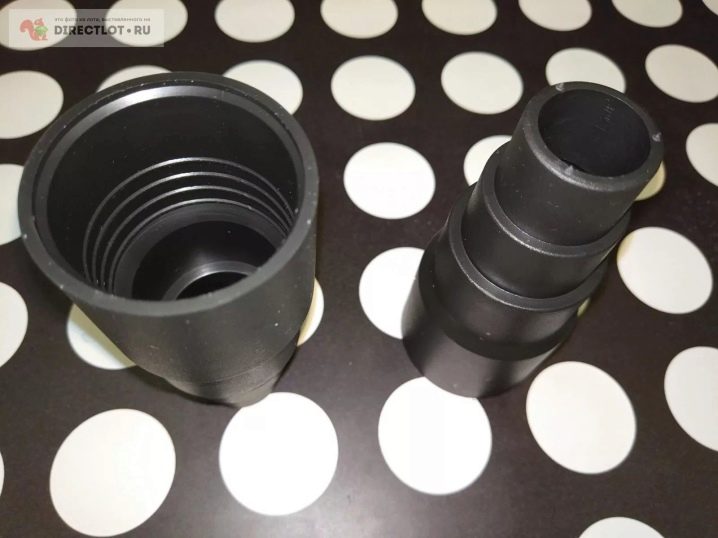
- Many construction vacuum cleaners know how to inform the user about clogged filters or an overfilled dust container. In many cases, this does not even require a full-fledged display - the "dashboard" can be limited to LEDs with corresponding signatures. Even in the simplest form of a warning system, the information it provides can be very valuable.

- Motor overload protection allows the unit to identify too high an intensity of work that threatens the serviceability of an industrial vacuum cleaner. A person may not understand that he is going to break the equipment, but such a smart machine is at least capable of shutting down itself. This will not speed up the cleaning process, but it will increase the service life of the device.

- Nozzles will be more useful at home, as well as where the removed waste can regularly change its shape and other characteristics. Thanks to the large set of attachments, the scope of convenient operation of the unit increases, it becomes better adapted to specific tasks.

Usage Tips
An industrial vacuum cleaner is a specific technique, it is specially designed for the most difficult working conditions and "survives" where its smaller counterparts would not cope with the task. Sometimes this causes the owners of the erroneous point of view that the unit is eternal, but in reality this, of course, is not the case. Like any other technique, a construction vacuum cleaner will serve you faithfully only if if you use it wisely and serve it on time.

First of all, you should read the instructions. Particular attention should be paid to the mode of operation, although this section should have been studied before making a purchase. This is most true if, when choosing a construction vacuum cleaner, you preferred a relatively inexpensive model - usually they are more productive and more durable than simple household units, but they also cannot work all day.
In the end, each device is individual, and even if you have used several different units in your life, it still does not hurt to read the instructions so as not to accidentally break the purchase by careless handling.
In addition, a fundamentally incorrect operation can lead to injury, because the vacuum cleaner is an electric device, moreover, very powerful.

There was a whole section above on how to choose a good construction vacuum cleaner correctly, but for many inexperienced consumers who do not put forward special requirements for such a unit, the dilemma sounds quite simple: pay extra for the simplest daily maintenance of the device or spend minimally in the future, compensating for the absence of costs with your own labor. The first option is provided by paper bags: they do not require any washing or cleaning, they are simply thrown away after use, but with the daily use of a construction vacuum cleaner, this can result in significant additional costs.
Most likely, sooner or later the moment will come when more has been spent on consumables than on the vacuum cleaner itself. All other types of construction units either require a rather rare replacement of the bag, or require regular replacement of ordinary clean water, or, in the case of a cyclone filter, do not require consumables at all. Any of these options is much more economical than all the others, however, then the unit will require maintenance after each cleaning session, and sometimes it just gets boring.


Another important maintenance element is regular filter cleaning. The filter's task is to keep out debris, but because of this, it accumulates, clogging the cells and reducing the productivity of the vacuum cleaner, which can no longer suck in air and dirt with the same force. If your unit is relatively simple, you will have to do everything the old fashioned way: guess for yourself that the time has come for cleaning, remove the filter from the case, clean it with any suitable means, rinse thoroughly under running water, dry it and return it to its place.

note that the pneumatic impact function relieves you of most of the above responsibilities, since the vacuum cleaner is able to clean itself using a reverse air flow, but in most cases such a procedure is still started by pressing a button and only at the initiative of the owner. Only some of the most expensive models are able to independently determine the level of the need to clean filters and automatically start a pneumatic impact without human intervention, but this is usually so expensive that in most cases such a technology does not seem justified.
Finally, it is worth mentioning the observance of elementary safety rules. A vacuum cleaner, even a simple and homemade one, is not a toy, and a powerful construction one, even more so, does not belong to the category. The high power of this unit in itself implies a respectful attitude towards it, therefore you should not try to vacuum the cat or your own leg - the consequences can be serious.
The instructions usually give a clear list of potential areas of use for each model, and if what you thought was not on the list, it is better not to experiment - this will save the device itself, and your property or loved ones.
How to choose the right construction vacuum cleaner, see below.











The comment was sent successfully.